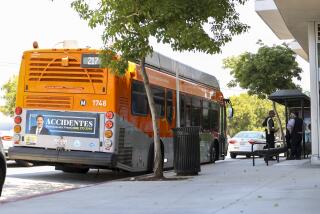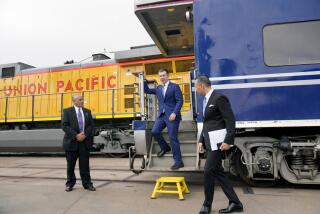Ground broken on controversial California bullet train project

California leaders including Gov. Jerry Brown on Tuesday launched the state’s high-speed rail project at a ceremony in downtown Fresno, declaring the city the nation’s high-speed rail capital and the “central cog” of a new transportation system.
At a historic and carefully choreographed groundbreaking staged in a decaying industrial section of the Central Valley city, near vacant lots where homeless gather at night, Brown sought to reset the public debate on the controversial $68-billion project, stressing the benefits the completed project could bring the state.
He compared the rail line to the construction of the great cathedrals of Europe, which took generations. “The high-speed rail links us from the past to the future, from the south to the north,” he said.
Addressing an audience of dozens of local residents, union members and federal, state and local politicians and contractors, the governor acknowledged that he, like many critics, once had misgivings about the state’s ability to secure the money needed to finish the project.
But he argued that as a long-term investment in California’s future and in the context of the state’s massive economy the bullet train “is not expensive.”
“We can afford it,” he told the supportive crowd from a stage set up adjacent to a freight railroad track, where the Fresno station of the San Francisco-to-Los Angeles line is scheduled to be built.
Brown and other speakers at the event had to contend with protestors from the Central Valley Tea Party, who yelled from behind a chain-link fence, in a vain attempt to disrupt the ceremony.
More than a dozen construction workers in hard hats surrounded the platform as the governor spoke.
Robbie Hunter, director of the state’s building trades union council, said the event marked the start of the “greatest infrastructure project, not only in the history of California, but the nation.” Hunter said the project will generate 66,000 jobs annually over the next 16 years.
Over the last two years, the California High-Speed Rail Authority has prevailed in a series of court challenges to the project, won a federal exemption from state environmental rules, secured several key legislative victories that improved its future funding and made a politically savvy bet to move up by several years the inauguration of service in Southern California.
Brown has made the project one of his highest priorities, investing considerable political capital in what he sees as an important part of his leadership legacy.
The concept for a California bullet train originated in Brown’s first terms as governor. Ever since, proponents have dreamed of a modern rail system that could better unite the state’s disparate regions. But moving that vision to reality has proved to be one of the most difficult and contentious political issues in recent state history.
“They have overcome quite a lot,” said Martin Wachs, a UCLA professor emeritus of urban planning. “They certainly have enormous hurdles ahead of them. The largest is locating adequate funding to start a statewide system.”
Voters approved a $9-billion bond measure for the rail project in 2008, and the Obama administration subsequently added grants of $3.2 billion. Last year, the Legislature agreed to provide 25% of future greenhouse gas — or cap-and-trade — fees, which could produce $250 million to $1 billion annually for the bullet train. The official completion of the San Francisco-to-L.A. system is scheduled for 2028, meaning that at the high end of revenue estimates it would have cumulative funding of about $26 billion — less than half of the estimated cost.
And if the project follows the typical pattern of cost growth for large government projects, experts say it is likely to significantly exceed the $68-billion price tag.
“Those projections are surrounded by uncertainty,” Wachs said. “The public should understand that the uncertainties are much greater than the certainties. But our political process doesn’t allow us to say ‘We don’t know what it will cost or how long it will take, but let’s get started anyway.’ ”
Congressional Republicans, who have controlled the House of Representatives, have vowed not to provide additional money for the project. The party’s successful takeover of the U.S. Senate in November was another blow.
“Now it is less likely they are going to get federal money,” said Rep. Kevin McCarthy (R-Bakersfield), the House majority leader. “They haven’t solved their problems yet. Their business plan doesn’t show it is viable. It could become like the skeleton of an unfinished building and they will have to stop.”
In McCarthy’s district, Bakersfield and Kern County have sued the project, though a recent federal regulatory ruling may make the suits moot. McCarthy said he expected that decision to be overturned.
Dan Richard, the rail board’s chairman, acknowledged that billions of additional dollars will be needed to complete the system. But he said advertising and real estate development rights along the route could provide large amounts of cash. And he doesn’t rule out additional federal support someday.
The state is counting on private investors to fund about a third of the system, but they are unlikely to commit until at least part of the system is up and running successfully.
“I don’t think there has been any argument that … another source of money” is needed, said Louis Thompson, chairman of a state oversight panel on the project.
Will Kempton, a longtime transportation executive and now executive director of the trade group Transportation California, said the project “has two very positive things going for it: the unwavering support of the governor and a dedicated stream of revenue through the cap-and-trade program. The latter is a game-changer with respect to the future prospects.”
The start of construction is a crucial political step that will make the bullet train harder to stop. And the decision to break ground at the Fresno depot site — even though the train station is not being built under the current rail contract — is a recognition of the support the city has given the project amid opposition elsewhere in the Central Valley.
“High-speed rail brings attention and focus back to city centers,” said Fresno Mayor Ashley Swearengin, who is among a handful of Republican officials supporting the project. “It is going to be easier for people to live in the middle of the state and do business elsewhere.”
Twitter: @RVartabedian
More to Read
Sign up for Essential California
The most important California stories and recommendations in your inbox every morning.
You may occasionally receive promotional content from the Los Angeles Times.











